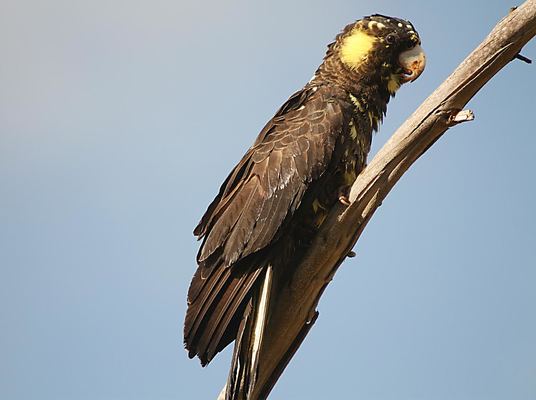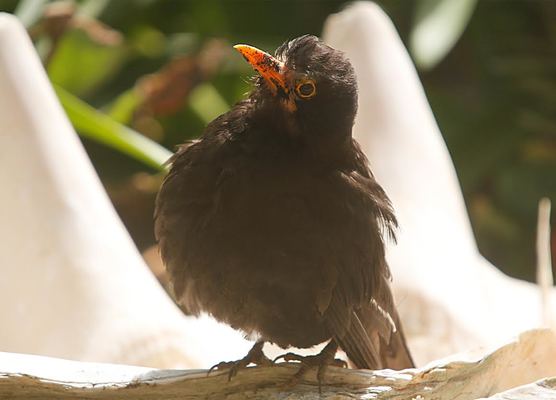By JEN CARR
THIS is a different story for me, and an exciting one as it’s had some input from some very knowledgeable experts in the field.
In November 2015, I was walking with Kevin in the Ocean Grove Nature Reserve and we came across a flock of yellow-tailed black cockatoos (YTBC) near the west dam. I wrote in ‘The Voice’ the following week that I thought that one of the birds was a young female cockatoo, and I also wrote that it was great to see that the birds had been breeding locally. I thought that it was a young bird as it had patchy yellow feathers on the breast and spots of yellow feathers on the crown and face. In my experience birds with spotty and streaky plumage are often young, so I assumed that this was a young bird.
I then received an email from ‘Voice’ reader Richard Weatherly regarding this bird. Richard is an internationally recognised artist and environmentalist, and you can check out his amazing work at richardweatherly.com.au/the-artist/. Richard wrote that “my interest in the young black cockatoo was because I have been puzzled for some time by birds of that species with additional patches of yellow in the plumage. Your premise that juvenile birds have wider yellow feather margins is correct, but they are not spotty like the one you photographed. I attach a much yellower bird photographed (badly!) in the Grampians. I had known of its presence for two and a half years (if it was the same bird) ranging from Glenthompson over to the Victoria Range. It appears to have perished in the 2013 fires. My understanding is that feather colour is made up like a printer’s machine with four colours, red, blue, yellow and black. However, in feather colour, blue is normally a structural colour derived from the molecular design of the feather (hence ‘Tindall Scattering’ can occur in blue plumage), while red and yellow are pigments that are predominantly determined by diet. National Geographic produced an interesting book on this subject about five years ago, written by Geoffrey Hill. To be yellow, a feather would need to lose both red and blue, or both a structural and a pigmented colour. Why does this happen? Surely the reasons are different? I have photographed a male red-rumped parrot that has lost most of his blue, seen feeding alongside a normal male, but to lose two unrelated colours puzzles me.”
After receiving Richard’s email I instantly realised that I had a lot to learn about bird coloration and that I had better learn it. I bought the book ‘Bird Coloration’ by Geoffery E. Hill and it is now my holiday reading. I also wrote to bird experts and legends Tom Fletcher, Barry Lingham, and by way of Tom Fletcher my email reached the great Trevor Pescott.
Trevor wrote: “It does seem that the local black-cockatoos may be in some trouble as I understand the plumage colour changes is usually seen in populations where some level of in-breeding is taking place. Typically it seems to be in populations of birds that are isolated. I think the term is leucism. Jen’s bird is not the first, nor the last to have the black replaced with yellow. Attached is one I saw at Birregurra about this time last year, with even more yellow – not quite the black-tailed yellow-cockatoo! I don’t know much about genetics or how this happens but I don’t think it is a good thing to see in the black-cockies that have some overall problems in food and breeding hollows.”
Barry, who is the president of the Geelong Field Naturalist Club, wrote: “Re the YTBC – yes, this is an unusual plumage, with more speckled yellow than I would normally expect. She does not appear all that well – possibly blood on the beak? I hope the extra yellow is not from beak and feather disease. It could be a juvenile bird with odd plumage, but I have not seen that before. There are a few strange versions of YTBCs about. In 2010, Jon Duthie (Friends of the Bluff) saw a bird near L Connewarre that was mostly yellow all over, except for a few patches of black around the tail and wing. This was a leucistic bird. He dubbed it a black-tailed yellow-cockatoo! Maybe your bird is related, showing a small amount of leucism.”
I sent the replies to Richard, who then wrote: “I believe Psittacine populations are quite susceptible to colour mutation; whether that is triggered by in-breeding I have no knowledge. However, the mechanism by which such genetic change is expressed in feather colour remains a puzzle to me. Yellow variants occur, almost certainly without disease. The question is how? if the condition is exacerbated by in-breeding, then it should be common in aviary specimens, as wholly yellow birds would no doubt be very attractive to purchasing collectors, as with species like golden pheasants, which have been taken by aviculture and turned from a beautiful bird and turned into a drab and yellow shadow of the natural version. Some more information: parrots have their own unique pigments for producing yellow and red known as psittacofulvins. They can produce vibrant colours when combined with structural blues. Unlike the normal carotenoids that are affected directly by diet in other birds, psittacofulvins are produced within the body of parrots. Within a species, psittacofulvins are regarded as less variable in expression among individuals than are carotenoid pigments.”
Up until I received these emails I thought that leucism was some extra white coloration in the feathers, but leucism, or leukism, is an abnormal plumage condition caused by a genetic mutation that prevents pigment, particularly melanin, from being properly deposited on a bird’s feathers. As a result, the birds do not have the normal, classic plumage colors listed in field guides, and instead the plumage have several color changes, including white patches where the bird should not have any, paler overall plumage that looks faint, diluted or bleached, or overall white plumage with little or no color discernable.
The degree of leucism, including the brightness of the white and the extent of pigment loss, will vary depending on the bird’s genetic makeup.
I have a little common blackbird in my garden that has white on the wings and white patches around the beak, so he or she is a leucistic blackbird. Of all the introduced bird in Australia, the common blackbird is my favourite, as it has the most beautiful song. So I love my little leucistic blackbird even though it has eaten many of the apricots off my tree. My photo of the blackbird is taken through the lounge room window as the bird doesn’t want to pose for a photo when I’m in the garden.
I want to thank everyone for their input and observations regarding this YTBC. I love progressing in my knowledge and learning from the experts, and there are still many questions unanswered regarding the patchy YTBC. I also love that ‘Voice’ readers do look at my photos and feel free to comment and give their opinions. It’s nice to know that a small photo in a local paper can provoke such discussion and learning. I will never again assume that a patchy YTBC is a young bird. Thank you Richard, Tom, Trevor and Barry.
Jen Carr, jencarr@y7mail.com








